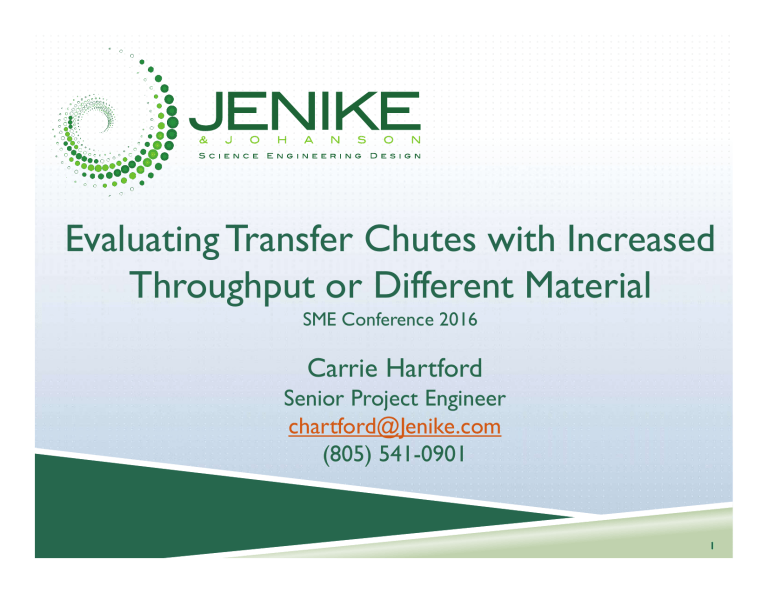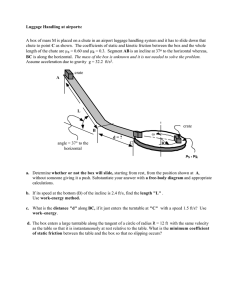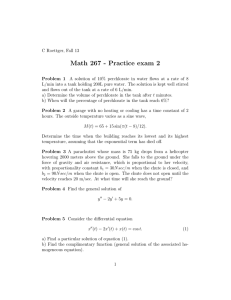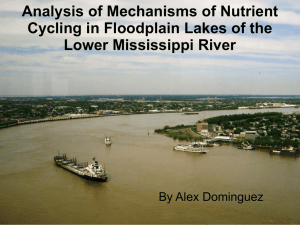
Evaluating Transfer Chutes with Increased Throughput or Different Material SME Conference 2016 Carrie Hartford Senior Project Engineer chartford@Jenike.com (805) 541-0901 1 OUTLINE Who is J&J? Review common transfer chute designs Discuss typical transfer chute problems Evaluate increasing throughput with existing infrastructure What about different material handled through an existing system? SCIENCE ・ ENGINEERING ・ DESIGN www.jenike.com 2 WE ARE A specialized engineering firm focusing on providing clients solutions to material handling applications SCIENCE ・ ENGINEERING ・ DESIGN www.jenike.com 3 PROJECT APPROACH Scientific – based on your materials Not a trial-and-error approach! On-site Inspections Technology Testing SCIENCE ・ ENGINEERING ・ DESIGN Engineering www.jenike.com 4 COMMON CHUTE FLOW PROBLEMS Buildup and Plugging Spillage Dust generation SCIENCE ・ ENGINEERING ・ DESIGN Wear www.jenike.com 5 VARIOUS CHUTE DESIGNS For free-flowing rocky material: For fine, sticky material: Rock box No ledges Hood and spoon Micro-ledges Minimize wear. Prevent plugging and minimize buildup. US Patent 4,646,910 What if the material is rocky and fine and sticky? Prevent plugging and minimize wear SCIENCE ・ ENGINEERING ・ DESIGN www.jenike.com 6 TRANSFER CHUTE DESIGN Prevent plugging Sufficient cross sectional area Control the stream Minimize wear Minimize dust generation Minimize particle attrition SCIENCE ・ ENGINEERING ・ DESIGN www.jenike.com 7 TRANSFER CHUTES: PREVENT PLUGGING Mitigate stalling: V1 V2 cos sin tan V1 Function of impact pressure: P1 V sin 2 1 2 g V2 PI V2 V1 ’ PI = Velocity along chute after impact = Impact velocity = Impact angle = Wall friction angle = Impact pressure = Bulk density Impact angle and sliding friction is critical in chute design: If + φ’= 90°, no resultant velocity SCIENCE ・ ENGINEERING ・ DESIGN www.jenike.com 8 QUESTIONS ASKED TO MAXIMIZE USAGE OF EXISTING PORT INFRASTRUCTURE Can we increase the throughput of the same material through the existing design? Consider: Belt sizing and speed Loads on the belt Support structure Material flow through the chutes Can we put a different material through the existing transfer chutes? Example: handling magnetite concentrate in iron ore transfer chutes What are the implications? Will material flow through the chutes? SCIENCE ・ ENGINEERING ・ DESIGN www.jenike.com 9 CASE STUDY Iron ore export terminal in South Africa Belt width: 1650 mm wide Belt speed: 5.5 m/s Flow rate: 10,000 tph Right angle transfer chute Rock box used to minimize wear Client needed to increase throughput. SCIENCE ・ ENGINEERING ・ DESIGN www.jenike.com 10 PROGRESSION OF PROBLEMS Increase in fines, mc, & flow rate Buildup in the chute (eventual plugging) Changed the flow path through the chute Changed the way material exited the chute Spillage, dusting, & premature belt wear Iron Ore SCIENCE ・ ENGINEERING ・ DESIGN www.jenike.com 11 TO ANALYZE AND DESIGN CHUTES Flow properties tests needed: • • • • • Bulk density Coefficient of sliding friction Particle size Particle density Chute tests • • • • Angle of repose SCIENCE ・ ENGINEERING ・ DESIGN Angle of repose Drawdown angle Wear tests Angle of internal friction Drawdown angle www.jenike.com 12 Discrete Element Modeling (DEM) WHY USE IT? Typically lower cost in the virtual world Some quantities are difficult to measure in a physical experiment Forces on boundaries What-if scenarios are easily done on the computer Changes to material properties, retrofits Min Velocity m/s etc.. Barge hold conveyor head chute SCIENCE ・ ENGINEERING ・ DESIGN www.jenike.com 13 CONTACT MODEL CALIBRATION a b c (i) c(ii) a) Confined consolidation; b) removal of load and confinement; c) unconfined shearing Contact model must allow for realistic representation of failure mode; particularly for cohesive materials Without an accurate contact model, DEM becomes a “pretty picture generator” SCIENCE ・ ENGINEERING ・ DESIGN www.jenike.com 14 CONTACT MODEL SELECTION – CRITICAL buildup and plugging Contact model without cohesion (not calibrated) Contact model with cohesion (calibrated) Be aware of your material, contact model. Implementation details matter! SCIENCE ・ ENGINEERING ・ DESIGN www.jenike.com 15 DEM APPLIED TO CHUTE DESIGN SCIENCE ・ ENGINEERING ・ DESIGN www.jenike.com 16 DEM ANALYSIS OF IRON ORE CHUTE Velocity (m/s) SCIENCE ・ ENGINEERING ・ DESIGN www.jenike.com 17 HOOD AND SPOON DESIGN Proper belt loading with spoon Proper stream capture with hood SCIENCE ・ ENGINEERING ・ DESIGN www.jenike.com 18 HOOD AND SPOON DESIGN Other benefits: Minimal downtown – chute went 2.5 years before changing out the head chute, still not much wear in the spoon. Eliminated belt tracking problems No spillage Reduced dusting significantly Obtained desired throughput SCIENCE ・ ENGINEERING ・ DESIGN www.jenike.com 19 OTHER ISSUES FROM INCREASED FLOWRATE Example: Material flies over the head chute Head chute height was set based on cross sectional area of material on belt and material trajectory. Belt speed and cross-sectional area of material on the belt increased to increase throughput. Caused some material to fly over the head chute. Chute was also fuller than designed for. SCIENCE ・ ENGINEERING ・ DESIGN Resulted in increased spillage and higher plugging potential. www.jenike.com 20 CHANGING MATERIAL Example: Using magnetite in hematite handling systems with rock boxes Cycle times of fine, sticky material versus lump ore needs to be evaluated SCIENCE ・ ENGINEERING ・ DESIGN www.jenike.com 21 CONCLUSION Increasing throughput and/or handling different material through existing infrastructure can have significant financial benefits. Material testing and DEM are good predictive tools to analyze the feasibility of a usage change. SCIENCE ・ ENGINEERING ・ DESIGN www.jenike.com 22 QUESTIONS? Carrie Hartford Senior Project Engineer chartford@Jenike.com (805) 541-0901 www.jenike.com 23


